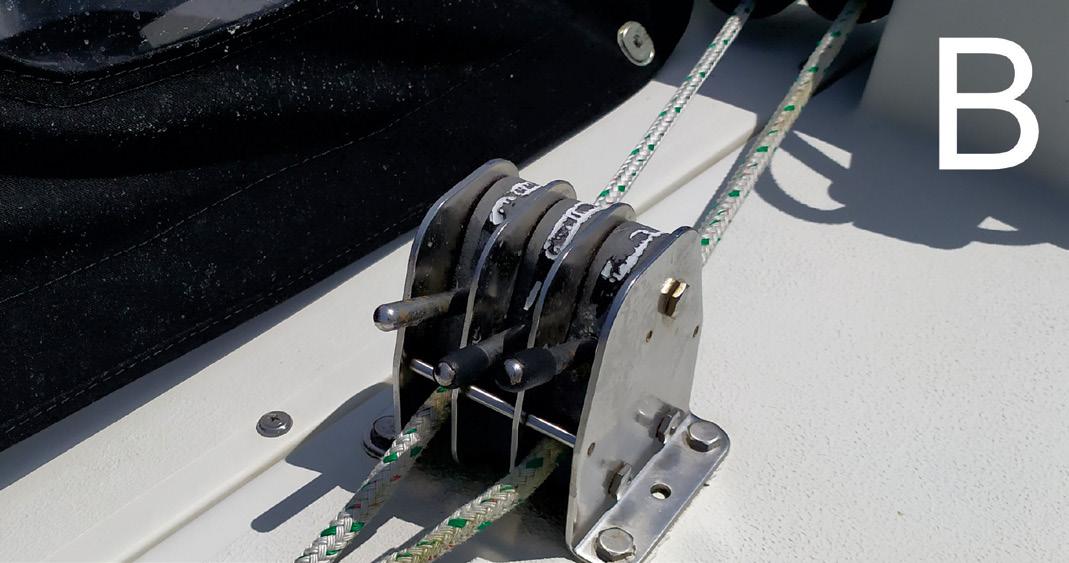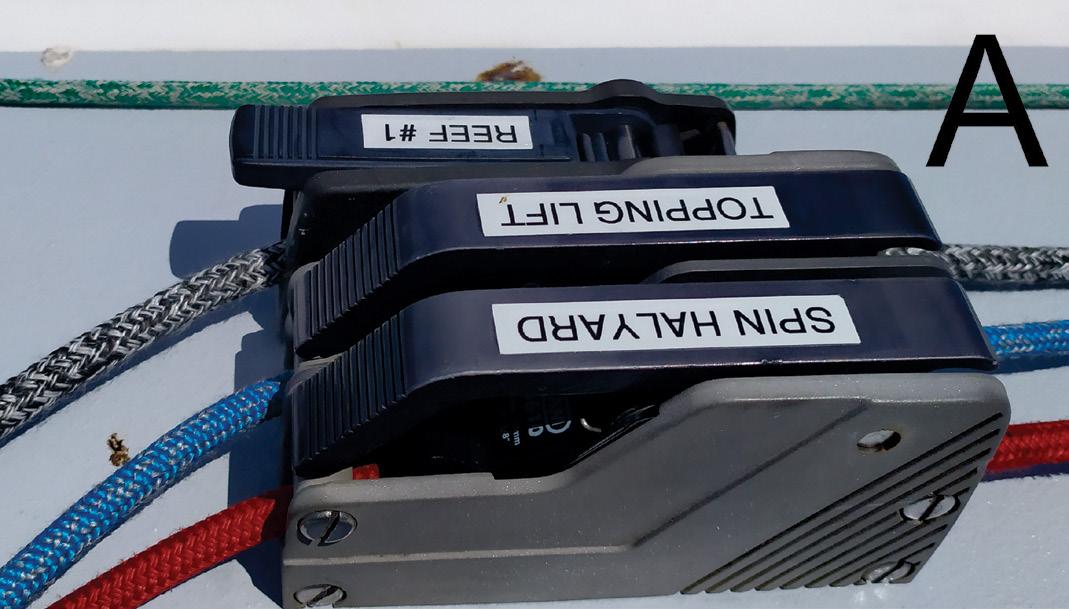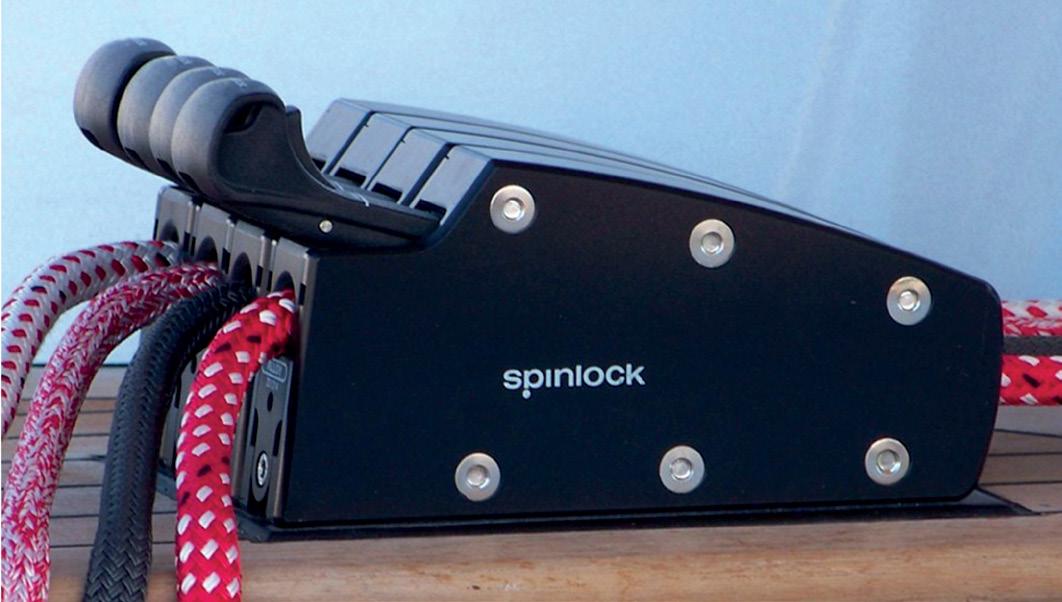
7 minute read
How-to: Cam Cleats and Clutches
from June 2020 48° North
by 48° North
by Alex and Jack Wilken
MOVING ON TO MOVING CLEATS
CLEAT COLLEGE, PART THREE
Combining the recent partial reopening of outdoor recreation, including day-use boating, with some seriously summery weather, the call of the water has been strong. Many of us have been feeling the urge to go sailing. No doubt, going sailing is a synergistic marriage of many moving parts and variables. Some of those essential “moving parts” help us keep sheets, halyards, and control lines from moving at all: cleats and clutches.
Over the last few months, we have been covering the different kinds of cleats. Until now, we have been mostly looking at cleats with no moving parts. This month’s cleats are the type that secure the line with moving parts. There are at least three varieties of these: cam cleats, rope clutches, and jammers. Each works slightly differently and therefore is better at a specific job. Let us go over how each works and which is best for each application.
Cam cleats hold the line between two spring-loaded cams, and they’ll be easily recognizable to any sailor. To engage it in the cleat, a line must be either pulled through the cams, or pressed downward into the cams with a slight pull toward you (away from the working end). The line can be pulled through the cleat by hand to adjust it, and can be released by pulling the line up out of the cams (Figure 1). Some have a fairlead (Figure 2) to keep the line close to the cams for ease of re-locking.
Cam cleats work well for lines that you can pull and adjust by hand. If you need a winch for the load, cam cleats become difficult to use and are not ideal—then you probably need a rope clutch. The sheets on small boats and sailing dinghies are often held with cam cleats. The mainsheet still uses it on bigger boats because purchase of the rigging tackle reduces the load. Halyards on sailing dinghies can also be held by cam cleats.
The problem with heavier loads is that the higher the load on the line, the harder it is to release it. In order to get the cams to disengage, you need to pull the line through the cleat slightly as you pull it up out of the cleat; and, the higher the load, the tighter the cams clamp on the line. This requires more force to pull it out.
Rope clutches come in many varieties (Figure 3) and have been evolving to meet higher and higher loads. They work by clamping the line between two surfaces with a lever controlling the clamping pressure. The surfaces, and the mechanisms that actuates the clamp, differ from model to model. Some are flat plates, and some have teeth to bite into the line for a stronger grip. The more the cleat bites into the line, the harder it is on the line; which can mean the line will need to be changed more frequently as it starts to chafe.
Rope clutches allow you to release the line under load by lifting the lever. You can also pull the line through the clutch to add tension, but they can let some of that tension slip back through before engaging and may have a harder time holding a heavy load. Each rope clutch is designed to work with a range of lines—10 to 12 mm or ¼ to ½ inch for example—the rope clutch will generally have a better holding power on the larger size it is rated for than the smaller sizes. You can splice a larger diameter line into the line where the rope clutch will hold it so that you can use a lighter line with smaller diameter for the rest of the length to save weight and still get the maximum hold.
Jammers seem the same as rope clutches because they hold the line in similar ways and are also typically lever-controlled (Figure 4). The similarities end there, however, as they are specifically designed to handle heavier loads. For this reason, they can not be released or tensioned under load. In order to release a jammer, you must take up some of the tension on a winch to be able to unlock it.
So, which cleat is best? If the line you wish to cleat off is constantly being adjusted and is under light load (able to be held and adjusted by hand), then a cam cleat is clearly the way to go. This is why most mainsheets use them. For medium loads and lines that need to be adjusted frequently, a rope clutch is usually best; unless some type of mechanical advantage reduces the load before the line gets to the cleat, in which case you may still use a cam cleat. For heavy loads such as halyards on larger, high-performance race boats, or for lines that can’t be held by rope clutches and don’t need to be adjusted frequently, a jammer may be the best option.
How to install? Now that you have selected the best cleating solution for your line, installation is a similar process to what we covered in our January 2020 article, “Installing a Horn Cleat.” However, the lead of the line coming into the cam cleat, clutch, jammer is much more important and has less tolerance for deviation compared to many fixed cleats.
If the angle of the line leading into the cam cleat deviates to one side or the other, cam cleats will not grip the line evenly and not function well. With clutches and jammers, they will grip the line just fine, but it will increase the friction and chafe on the line, as well as begin to put a side load on the hardware, for which they are not designed. Too much of this can pull them out of the deck.
If the angle of line that is led into the cam cleat rises above the plane of the cams, it will become less secure, to the point where it will not hold at all. On the other hand, if the angle of the line is below the plane of the cams, the cleat will function well. You only need to worry about chafe on the line. With clutches and jammers, a little up or down angle for the line leading into the hardware will work (down is better), but it will also increase chafe. Sufficient up-angle can be as bad as a side-load.
In short, it is better to have the line leading as straight as possible into the cleat, clutch, or jammer to get the maximum performance and minimum friction. You may need to use
Figure 1: (A) Line pulled through the cam cleat and locked in place. (B) Line pulled up out of the cam cleat to release it.



Figure 2: (A) Cam cleat on fairing block. (B) Cam cleat mounted on purchase to control mainsheet traveler. (C) Cam cleat mounted to purchase to control mainsheet. (D) Fairleads mounted on cam cleats to keep the line near the clam cleats.
Figure 3: (A) A couple of different rope clutches where the lever actuates a clamping surface that is held against the line with springs to apply more clamping pressure to hold the line and allow it to be pulled tighter through the rope clutch when closed. (B) Simple pivoting rope clutch that holds the line in place when closed.

fairleads and or fairing blocks to ensure the proper alignment (Figure 2). And, as always, with mounting hardware use appropriate backing plates.
Controlling the various lines on boats is a core fundamental of sailing. From the simple cat-boat sailing dinghy in which you just hold the mainsheet by hand but the main halyard is secured using a cleat; to the large cruiser or racer that will employ dozens of cleats, clutches, or jammers at any given moment—we all need cleats. This is why there are so many kinds of cleats for all the jobs we need them to do. And we are still inventing more...
Figure 4: Jammers. Able to handle heavier loads than rope clutches, but they need the tension taken off to be able to release them.
Alex and Jack Wilken are lifelong cruisers, professional shipwrights, USCG licensed captain, and the owners of Seattle Boat Works.









